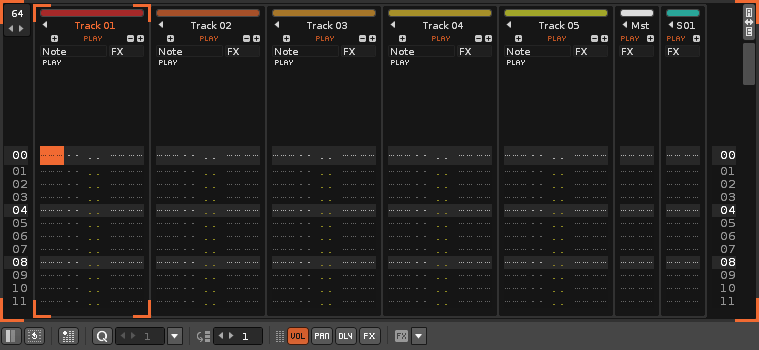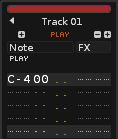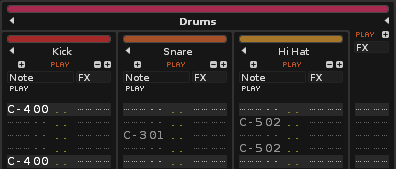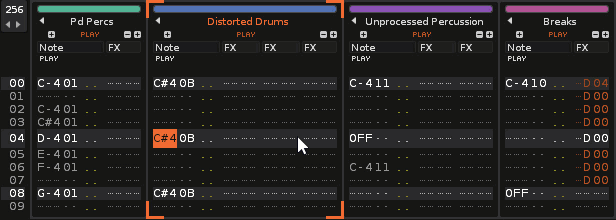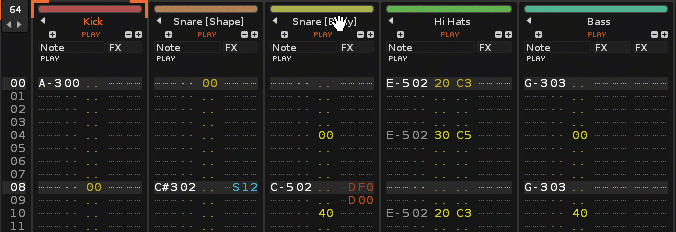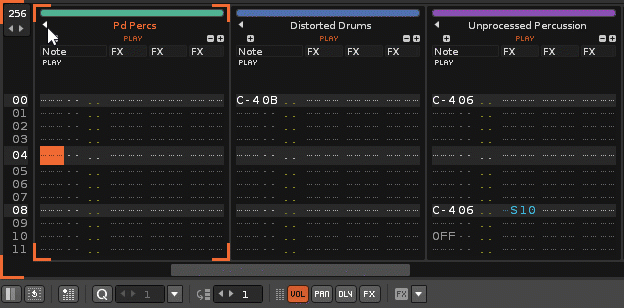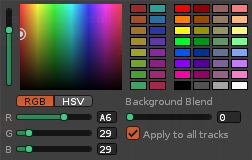Pattern Editor: Difference between revisions
imported>Taktik No edit summary |
No edit summary |
||
| (116 intermediate revisions by 8 users not shown) | |||
| Line 1: | Line 1: | ||
= Pattern Editor = | = Pattern Editor = | ||
[[Image:3.2_tab-edit.png]] | |||
The Pattern Editor is the main editor used to create music in Renoise and is opened with the Edit tab at the top left of the interface. Instruments are recorded by entering notes onto lines in the order that they are to be played, from top to bottom. This is done with the [[Tracker Interface]], so if you're unfamiliar with this method of working, you should [[Tracker Interface|read through that section]] of the manual before continuing here. | |||
A pattern can contain multiple tracks, typically one for each different instrument and each with their own separate set of effects. Songs are created by arranging a sequence of patterns with the [[Pattern Sequencer]] and the [[Pattern Matrix]]. So, a pattern is normally used to represent a specific section of a song that may be repeated again in future. The length and speed of a pattern can be changed, so the exact nature of a specific pattern can vary wildly depending on the whims of the composer. | |||
You may find it useful to watch [https://youtu.be/L1Ytodmo1OA a video about the various track types]. | |||
[[Image:3.2_patterneditor.png]] | |||
== Track Types == | |||
There are four different types of track in the Renoise Pattern Editor: | |||
=== Tracks === | |||
[[Image:3.2_patterneditor-track.png]] | |||
These standard tracks are where you record notes onto the lines of a [[Tracker Interface#Columns|Note Column]]. Each track also features [[Tracker Interface#Columns|Effect Columns]], which are used to apply [[Effect Commands]] to instruments and to control [[Effect Chains|Track Effects]]. | |||
=== | === Group Tracks === | ||
[[Image: | [[Image:3.2_patterneditor-group.png]] | ||
Used to group together similar Tracks, such as all percussion, all synths etc. The child tracks have their output automatically routed through the parent track, though you can change this with the [[Effect Chains#Pre_and_Post_Mixer_Effects|Pre Mixer]]. This means that [[Effect Chains|Track Effects]], [[Graphical Automation|Automation]] and [[Effect Commands]] used in the Group Track will affect the audio coming from the regular Tracks contained within it. Notes cannot be entered into Group Tracks and so they only feature [[Tracker Interface#Columns|Master FX]] columns. | |||
=== Send Tracks === | === Send Tracks === | ||
[[Image: | [[Image:3.2_patterneditor-send.png]] | ||
Send Tracks are fed audio from other tracks using [[Routing_Devices#.23Send_Device|Send Devices]] and are typically used to apply the same set of [[Effect Chains|Track Effects]] to multiple tracks at once, though there is a whole range of possibilities for creatively complex routing. Notes cannot be entered into Send Tracks and so they only feature [[Tracker Interface#Columns|Master FX]] columns. | |||
You may find it useful to watch our video covering the subject of [https://youtu.be/jChkwB8b7to Send Tracks & Devices]. | |||
=== Master Track === | === Master Track === | ||
[[Image: | [[Image:3.2_patterneditor-master.png]] | ||
The Master Track is where all audio produced by the other tracks finally ends up, so effects placed here will therefore affect the output of the entire song. To help manage the master signal, the [[Effect_Chains#Pre_and_Post_Mixer_Effects|Post-Mixer device]] in the Master Track has a few more options than the other tracks. Notes cannot be entered into the Master Track and so it only features [[Tracker Interface#Columns|Master FX]] columns. | |||
== Track Options == | |||
=== Muting Tracks === | |||
An individual track can be muted by left-clicking on the 'Play' text underneath its name. Clicking again will un-mute it. Right-clicking a track's 'Play' text will solo it, muting all of the others so that only the audio from that track is heard. Right-clicking again will un-mute the other tracks. Similar operations can be performed on the [[Track_Scopes#Mouse_Operations|Track Scopes]]. | |||
! | <!-- RENOISE_NO_PDF_START --> | ||
[[image:3.2_patterneditor-mutingtracks.gif]] | |||
<!-- RENOISE_NO_PDF_STOP --> | |||
=== | === Organising Tracks === | ||
Any track can be renamed by double-clicking on its name and typing in a new one. This is also true for [[Tracker Interface#Columns|Note Columns]]. | |||
To | To add or remove tracks, you can use the ''"Edit->Insert Track" (Left Control/Command + T)'' and ''"Edit->Delete Track" (Left Control/Command + Left Shift + T)'' commands from the menu in the Upper Status Bar. If the currently selected track is a regular Track, then a new Track will be added to the right of it. If the currently selected track is a Send Track or the Master Track, then another Send Track will be added. | ||
To add a group track, use the ''"Edit->Insert Group" (Left Control/Command + G)'' command or drag one track onto another while holding down Alt. This will create a new group and add both tracks to it. | |||
To | To reposition a track left-click and hold the button on its name, then drag the track to either side. This can be done in both the Pattern Editor and the [[Mixer]]. You can also move tracks by using the ''Ctrl/Command + Alt + Left/Right'' shortcuts. | ||
<!-- RENOISE_NO_PDF_START --> | |||
[[image:3.2_patterneditor-orderingtracks.gif]] | |||
<!-- RENOISE_NO_PDF_STOP --> | |||
To duplicate tracks, you can use the ''"Edit->Duplicate Track" (Left Control/Command + D)'' command from the menu in the Upper Status Bar. | |||
=== | === Collapsing Tracks === | ||
To | To collapse a track, press the small arrow to the left of the track's name. This just hides most of its information; the track will still play as normal. You can collapse a Group of tracks in the same way and also collapse ''the Group's'' [[Tracker Interface#Columns|Master FX]] column using the arrow to the right of its name. | ||
Using [[#Pattern Editor Control Panel|Single Track Edit Mode]] will cause all of the tracks and groups to collapse, except for the track that the cursor is currently in. Moving the cursor to other tracks while in this mode will automatically expand those tracks and collapse the one you were previously in. | |||
<!-- RENOISE_NO_PDF_START --> | |||
[[Image:3.2_patterneditor-collapsingtracks.gif]] | |||
<!-- RENOISE_NO_PDF_STOP --> | |||
=== Changing Track Colors === | |||
To change the color of a track, left-click on the color slot above the track name. Using the color picker you can move around the grid to choose a color, while the left-hand slider controls the saturation value. You can also pick colors from the available swatches or right click on a swatch to save the current color to it. The ''"Background Blend"'' slider controls the amount of color present in the track's background. Enabling ''"Apply to all tracks"'' will apply the slider value to all of the tracks at once. | |||
[[image:3.2_patterneditor-colours.png]] | |||
== | == Pattern Editor Control Panel == | ||
At the bottom of the Pattern Editor is the control panel: | |||
[[Image:3.2_patterneditor-controlpanel.png]] | |||
* '''Single Track Edit Mode:''' When enabled, all tracks will be collapsed except for the currently selected track. | |||
* '''Pattern Wrap Mode:''' Toggle what will happen upon reaching the end of a pattern when [[Recording_and_Editing_Notes#Entering_Notes_Step_By_Step|entering notes step-by-step]] in Edit Mode. When enabled, the cursor will move to the top of the next pattern in the sequence. When disabled, the cursor will move back to the top of the current pattern. | |||
* '''Pattern Automation Recording Mode:''' When enabled, [[Effect_Commands#Device_Commands|right-clicked]] and [[MIDI Mapping|MIDI mapped]] parameters are recorded into [[Graphical Automation|Automation]] instead of the track's [[Tracker Interface#Columns|Master FX Column]]. | |||
* '''Quantize Controls:''' Toggle live quantization. The value box to the right specifies the quantization value in lines. Use the drop-down menu next to the value box to manually quantize a selected area of the current pattern after recording. Quantization is covered in-depth [https://youtu.be/dGkoKWA-2Dg in this video]. | |||
* '''Edit Step:''' Set how many lines the cursor will skip down in the Pattern Editor when entering a note or effect. | |||
* '''Vol/Pan/Dly/FX:''' Toggle the [[Tracker Interface#Columns|volume, panning, delay and Local FX sub-columns]] for the currently selected track. | |||
* '''FX Drop-down Menu:''' Quickly show and insert [[Effect Commands]]. | |||
Latest revision as of 20:33, 11 July 2023
Pattern Editor
The Pattern Editor is the main editor used to create music in Renoise and is opened with the Edit tab at the top left of the interface. Instruments are recorded by entering notes onto lines in the order that they are to be played, from top to bottom. This is done with the Tracker Interface, so if you're unfamiliar with this method of working, you should read through that section of the manual before continuing here.
A pattern can contain multiple tracks, typically one for each different instrument and each with their own separate set of effects. Songs are created by arranging a sequence of patterns with the Pattern Sequencer and the Pattern Matrix. So, a pattern is normally used to represent a specific section of a song that may be repeated again in future. The length and speed of a pattern can be changed, so the exact nature of a specific pattern can vary wildly depending on the whims of the composer.
You may find it useful to watch a video about the various track types.
Track Types
There are four different types of track in the Renoise Pattern Editor:
Tracks
These standard tracks are where you record notes onto the lines of a Note Column. Each track also features Effect Columns, which are used to apply Effect Commands to instruments and to control Track Effects.
Group Tracks
Used to group together similar Tracks, such as all percussion, all synths etc. The child tracks have their output automatically routed through the parent track, though you can change this with the Pre Mixer. This means that Track Effects, Automation and Effect Commands used in the Group Track will affect the audio coming from the regular Tracks contained within it. Notes cannot be entered into Group Tracks and so they only feature Master FX columns.
Send Tracks
Send Tracks are fed audio from other tracks using Send Devices and are typically used to apply the same set of Track Effects to multiple tracks at once, though there is a whole range of possibilities for creatively complex routing. Notes cannot be entered into Send Tracks and so they only feature Master FX columns.
You may find it useful to watch our video covering the subject of Send Tracks & Devices.
Master Track
The Master Track is where all audio produced by the other tracks finally ends up, so effects placed here will therefore affect the output of the entire song. To help manage the master signal, the Post-Mixer device in the Master Track has a few more options than the other tracks. Notes cannot be entered into the Master Track and so it only features Master FX columns.
Track Options
Muting Tracks
An individual track can be muted by left-clicking on the 'Play' text underneath its name. Clicking again will un-mute it. Right-clicking a track's 'Play' text will solo it, muting all of the others so that only the audio from that track is heard. Right-clicking again will un-mute the other tracks. Similar operations can be performed on the Track Scopes.
Organising Tracks
Any track can be renamed by double-clicking on its name and typing in a new one. This is also true for Note Columns.
To add or remove tracks, you can use the "Edit->Insert Track" (Left Control/Command + T) and "Edit->Delete Track" (Left Control/Command + Left Shift + T) commands from the menu in the Upper Status Bar. If the currently selected track is a regular Track, then a new Track will be added to the right of it. If the currently selected track is a Send Track or the Master Track, then another Send Track will be added.
To add a group track, use the "Edit->Insert Group" (Left Control/Command + G) command or drag one track onto another while holding down Alt. This will create a new group and add both tracks to it.
To reposition a track left-click and hold the button on its name, then drag the track to either side. This can be done in both the Pattern Editor and the Mixer. You can also move tracks by using the Ctrl/Command + Alt + Left/Right shortcuts.
To duplicate tracks, you can use the "Edit->Duplicate Track" (Left Control/Command + D) command from the menu in the Upper Status Bar.
Collapsing Tracks
To collapse a track, press the small arrow to the left of the track's name. This just hides most of its information; the track will still play as normal. You can collapse a Group of tracks in the same way and also collapse the Group's Master FX column using the arrow to the right of its name.
Using Single Track Edit Mode will cause all of the tracks and groups to collapse, except for the track that the cursor is currently in. Moving the cursor to other tracks while in this mode will automatically expand those tracks and collapse the one you were previously in.
Changing Track Colors
To change the color of a track, left-click on the color slot above the track name. Using the color picker you can move around the grid to choose a color, while the left-hand slider controls the saturation value. You can also pick colors from the available swatches or right click on a swatch to save the current color to it. The "Background Blend" slider controls the amount of color present in the track's background. Enabling "Apply to all tracks" will apply the slider value to all of the tracks at once.
Pattern Editor Control Panel
At the bottom of the Pattern Editor is the control panel:
- Single Track Edit Mode: When enabled, all tracks will be collapsed except for the currently selected track.
- Pattern Wrap Mode: Toggle what will happen upon reaching the end of a pattern when entering notes step-by-step in Edit Mode. When enabled, the cursor will move to the top of the next pattern in the sequence. When disabled, the cursor will move back to the top of the current pattern.
- Pattern Automation Recording Mode: When enabled, right-clicked and MIDI mapped parameters are recorded into Automation instead of the track's Master FX Column.
- Quantize Controls: Toggle live quantization. The value box to the right specifies the quantization value in lines. Use the drop-down menu next to the value box to manually quantize a selected area of the current pattern after recording. Quantization is covered in-depth in this video.
- Edit Step: Set how many lines the cursor will skip down in the Pattern Editor when entering a note or effect.
- Vol/Pan/Dly/FX: Toggle the volume, panning, delay and Local FX sub-columns for the currently selected track.
- FX Drop-down Menu: Quickly show and insert Effect Commands.
